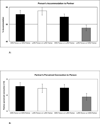A Dyadic Perspective on Speech Accommodation and Social Connection: Both Partners' Rejection Sensitivity Matters
- PMID: 25393028
- PMCID: PMC4430452
- DOI: 10.1111/jopy.12149
A Dyadic Perspective on Speech Accommodation and Social Connection: Both Partners' Rejection Sensitivity Matters
Abstract
Findings from confederate paradigms predict that mimicry is an adaptive route to social connection for rejection-sensitive individuals (Lakin, Chartrand, & Arkin, 2008). However, dyadic perspectives predict that whether mimicry leads to perceived connection depends on the rejection sensitivity (RS) of both partners in an interaction. We investigated these predictions in 50 college women who completed a dyadic cooperative task in which members were matched or mismatched in being dispositionally high or low in RS. We used a psycholinguistics paradigm to assess, through independent listeners' judgments (N = 162), how much interacting individuals accommodate phonetic aspects of their speech toward each other. Results confirmed predictions from confederate paradigms in matched RS dyads. However, mismatched dyads showed an asymmetry in levels of accommodation and perceived connection: Those high in RS accommodated more than their low-RS partner but emerged feeling less connected. Mediational analyses indicated that low-RS individuals' nonaccommodation in mismatched dyads helped explain their high-RS partners' relatively low perceived connection to them. Establishing whether mimicry is an adaptive route to social connection requires analyzing mimicry as a dyadic process influenced by the needs of each dyad member.
© 2014 Wiley Periodicals, Inc.
Conflict of interest statement
Declaration of Conflicting Interests
The author(s) declared no potential conflicts of interest with respect to the research, authorship, and/or publication of this article.
Figures


References
-
- Aguilar L. Gender Identity Threat in Same & Mixed-Gender Negotiations: Speech accommodation & relational outcomes. Retrieved from Dissertation Abstracts International. (3454130) 2011
-
- Anderson AH, Bader M, Bard EG, Boyle EA, Doherty G, Garrod S, Isard AD, Kwotko J, McAllister J, Miller J, Sotillo C, Thompson HS, Weinert R. The HCRC Map Task corpus. Language and Speech. 1991;34(4):351–366.
-
- Ashton-James C, van Baaren R, Chartrand T, Decety J. Mimicry and me: The impact of mimicry on self-construal. Social Cognition. 2007;25:518–535.
-
- Ayduk O, Downey G, Kim M. Rejection sensitivity and depressive symptoms in women. Personality and Social Psychology Bulletin. 2001;27(7):868–877.
-
- Babel M, Bulatov D. The role of fundamental frequency in phonetic accommodation. Language and Speech. 2012;55:231–248. - PubMed
Publication types
MeSH terms
Grants and funding
LinkOut - more resources
Full Text Sources
Other Literature Sources
Medical

